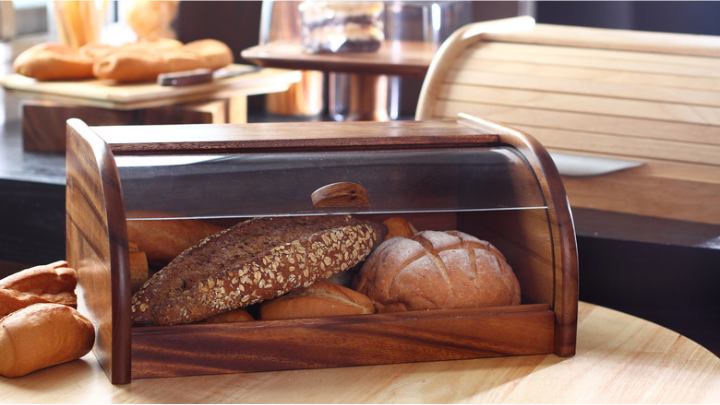How you store your sourdough bread largely determines its freshness and quality. This bread has a higher moisture content than other types of bread and is prone to drying out.
When it dries out, you lose the delight of its chewy crust, soft interior, and tangy flavor. If you know how to store your sourdough loaf properly, you can enjoy this richness for some days.
Unlike many other types of bread, you need to be extra careful with sourdough. It is unique by itself – from its recipe to its flavors. To get the best of your sourdough bread, how you store it is very important.
In this article, you will learn about the shelf life of sourdough bread, how to store it, the factors that trigger spoilage, and the signs of spoilage.
How long does sourdough bread last?

Homemade sourdough bread will last 3 to 5 days under proper storage conditions, and store-bought varieties can last up to a week. This is because homemade bread does not contain preservatives like store-bought bread.
An open loaf exposed to warm temperatures will set out faster and begin to stale. This can happen in a shorter time frame than the expected shelf life.
The bread may not mold, but it will not taste palatable either. Moreover, sourdough bread is no longer fresh after 24 hours of baking or purchase.
That is to say that how long your bread lasts depends on how it was made and how you stored it.
Ways to store sourdough bread
1. Leave it unwrapped in the kitchen
This method is ideal for a loaf you intend to eat at once. You can leave the bread unwrapped and uncut at room temperature. Ensure you eat it at once after cutting. Otherwise, it will begin to stale.
If you are not eating it at once, use any of the other methods below. Also, if you are sure you will finish the bread within 24 hours, you can leave the other half on your kitchen counter, but the cut side should be facedown on the breadboard.
2. Invest in a bread box

A bread box may seem unnecessary, but it will be worth it. Bread boxes are built with wood or metal to prevent air from getting to the bread. It keeps the crust crispy and the interior moist and soft.
Keep the cut side facedown in the bread box to prevent it from coming in contact with air and going stale.
3. Keep the bread in airtight wraps and bags
Paper bags, plastic bags, linen bags, aluminum foils, tea towels, etc. are some airtight wraps and bags that can help to keep your loaf away from air and excess moisture.
But you should make it breathable because too much moisture in the bag or wrap will encourage mold growth. Breathable linen and brown paper bags will absorb the moisture the bread releases, thereby retaining its crust.
Keep the wrapped bread in a cool, dry place, away from sunlight. These bags and wraps can keep sourdough bread for 3 to 5 days.
4. Beeswax wraps and bags are great too

Beeswax wraps are natural reusable storage materials. They can keep your loaf of bread fresh for up to 3 days if it is airtight and kept away from sunlight and moisture. Unlike single-use plastic and paper bags, they are eco-friendly.
Allow the bread to cool, then wrap it with the beeswax wrap and use your hands to make a firm seal against the bread.
5. Your microwave is also a good place
I bet you didn’t know this, and you’re wondering how and why. I’ll tell you. If you do not want to buy the “ancient” bread boxes, you can improvise with your microwave if you leave it off and keep the door shut.
As long as the microwave is shut, the temperature is constant, and air does not come in to cause staling or spoilage.
6. Not the refrigerator!
We all love to keep bread in the fridge so it is fresh and ready to use the next day. Well, that is the wrong storage method.
You should not keep sourdough or any other type of bread in the fridge. The air in the fridge will dry up your bread and make it hard and stale faster.
7. Use the freezer instead
The freezer is the best place to store whole or sliced sourdough long-term. Allow the bread to cool before you put it in a cling wrap and aluminum foil. Afterward, you can freeze it for 6 months.
When you are ready to use the bread, allow it to thaw on the kitchen counter while you preheat the oven to 350°F (175°C). Bake for 15 minutes and allow it to cool before you cut into it.
Can sourdough bread go bad?
Yes, sourdough bread can go bad. Exposing your bread to air, contaminants, and odorous foods in the freezer can trigger spoilage.
Factors that influence spoilage in sourdough bread
Here are some factors that could be the reason why your sourdough bread went off:
Quality of ingredients used
Fresh and high-quality ingredients can guarantee longer shelf life. Premium quality all-purpose or bread flour contains more protein and will create a stronger gluten structure, which is necessary to keep the bread fresh for longer.
Also, using filtered or bottled water instead of chlorinated tap water can help keep your bread longer. Seeds, nuts, and dried fruits can introduce moisture into the bread and shorten its shelf life.
Preparation method
Fermentation time and baking temperature can also affect the shelf life of sourdough bread. If the dough does not ferment at the right temperature and duration, the correct flavors and structure will not develop. These errors can shorten the shelf life.
Additionally, baking at a higher temperature for a shorter time or baking at a lower temperature for longer can reduce the shelf life of your bread. Overbaking and underbaking your bread will shorten its lifespan.
Therefore, you should bake your bread at the right temperature and duration, ensuring it contains the right amount of moisture that won’t make it too dry or moist.
Signs of spoilage in sourdough bread
Mold growth
When sourdough is exposed to air, mold spores land on it, and because they are highly prolific, they multiply rapidly and dominate the bread.
Mold can grow beyond the surface into the interior and trigger spoilage. This is the first thing to look out for when examining your bread for spoilage.
Unpleasant look and feel
When sourdough bread stales, it becomes hard. But when it becomes too hard, feels rubbery, and has dark spots instead of the golden brown color, it has spoiled, and you should not eat it.
An off smell
If you are very familiar with fresh sourdough, you will know when it has got an off smell. The pleasant, sour, and yeasty aroma of fresh sourdough gives way to a medicine-like smell when the bread has gone off.
An off taste
When sourdough bread has gone off, it develops a funny taste that will be nothing like fresh sourdough. It is bitter, herby, and nothing like bread.
However, tasting bread to check for spoilage should be your last resort if you cannot find mold growth or detect an off smell.
Is stale sourdough the same as spoiled sourdough bread?
Stale sourdough is not the same as spoiled sourdough bread. While you can still eat stale sourdough bread, you cannot eat spoiled bread.
Staling is caused by starch retrogradation, a process whereby the starch molecules in bread dry out and go back to their crystalline state.
Stale sourdough is hard but can be salvaged with water and a little more baking. On the other hand, spoiled sourdough is bad and can cause food poisoning.
Can you eat stale sourdough bread?
Yes, you may eat stale sourdough bread, but not directly. Stale sourdough bread is not appetizing. Rather than eat stale sourdough bread, you can use it to make new and fresh meals that require bread.
What to do with stale sourdough bread?
If you just want your crusty bread back, you can revive it with water and your oven. Preheat the oven to 390°F (200°C). Wet the stale bread, wrap it with aluminum foil, and bake for 15 minutes. Your bread will come out fresh again.
However, before you do this, you should be sure the bread is stale and not spoiled.
Other ways to use up stale sourdough bread are:
- Make breadcrumbs that you can use to thicken sauces and soups, as a garnish for sweet and savory foods, as crispy coating for fried foods, as toppings for casseroles, pasta bakes, and muffins
- Cut up the bread and store it in the freezer. It will come in handy when making pie fillings
- You can also make sourdough croutons or crispbread
- Stale sourdough can be transformed into French toast
- Make bread and butter pudding, crostini, Italian bread salad, fried sandwich, or eggy bread with stale sourdough
Extra tips on how to make sourdough bread last longer
- Make a rich dough. Add enough butter, milk, and eggs to make the bread stay soft for a longer period
- You can add tangzhong to the dough to extend the shelf life
- Add some olive oil to the dough before baking. This will help to keep it soft for a longer period
- Bake at the right temperature and for the right duration
- Do not slice the loaf until it is cooled and you are ready to serve it
- Slice the bread in the middle instead of at the ends
FAQs
Can you eat sourdough bread that has mold?
No, you shouldn’t eat bread with mold. Even if the mold is present on only a small portion of the bread, you should discard the entire bread. Mold produces toxins that cause food poisoning and can negatively impact your health.
Can you store raw sourdough before baking?
Yes, you can. Storing raw sourdough can help speed up preparation time. To store raw sourdough, wrap it in plastic wrap, double-proof proof with a plastic bag, and refrigerate it for not more than 3 days.
Will commercial yeast make sourdough go bad faster?
Yes, it will. Commercial yeast reduces fermentation in sourdough and will make it mold faster, thereby shortening its lifespan.
How long should you proof sourdough?
How long you proof sourdough depends on the method you are using. If you proof at room temperature, leave the dough to sit covered for 3 to 4 hours.
If you want to proof the dough in the refrigerator, leave it a while at room temperature and refrigerate for 12 to 15 hours.
You can also speed up proofing using a warm oven, a warm cooler, or a proof box.
Conclusion
Sourdough is best enjoyed fresh. It will not last forever, but you can maximize your bread for the 3 to 5 days of storage. Keep your loaves of bread out of the refrigerator.
If you must keep them chilled, wrap them in plastic wrap, double-proof the wrap with a plastic bag, and keep it frozen for two months.
You can also make your dough and refrigerate it in small portions. This way, you can enjoy freshly baked sourdough bread every day for three days.
Whichever storage method you use, ensure it is safe from germs, pests, insects, and moisture. When you take it out, carefully examine it for signs of spoilage. If you see a compromised loaf, discard it and avoid food poisoning.
Also, see how to store banana bread to keep it fresh and edible for days.
Thanks for reading.

